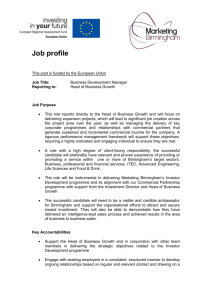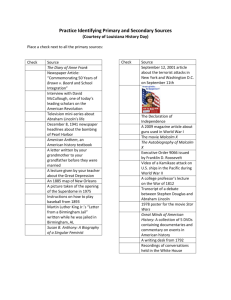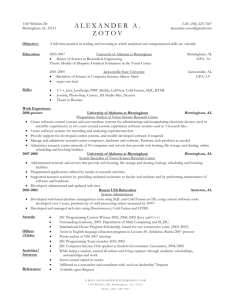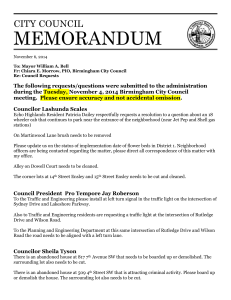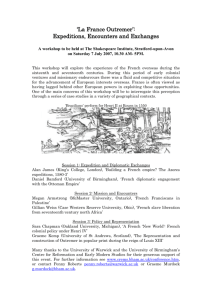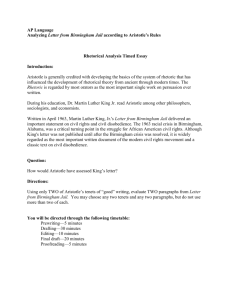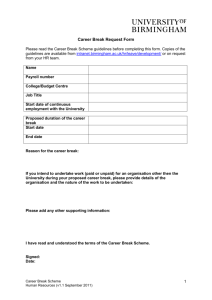1 - University of Birmingham
advertisement
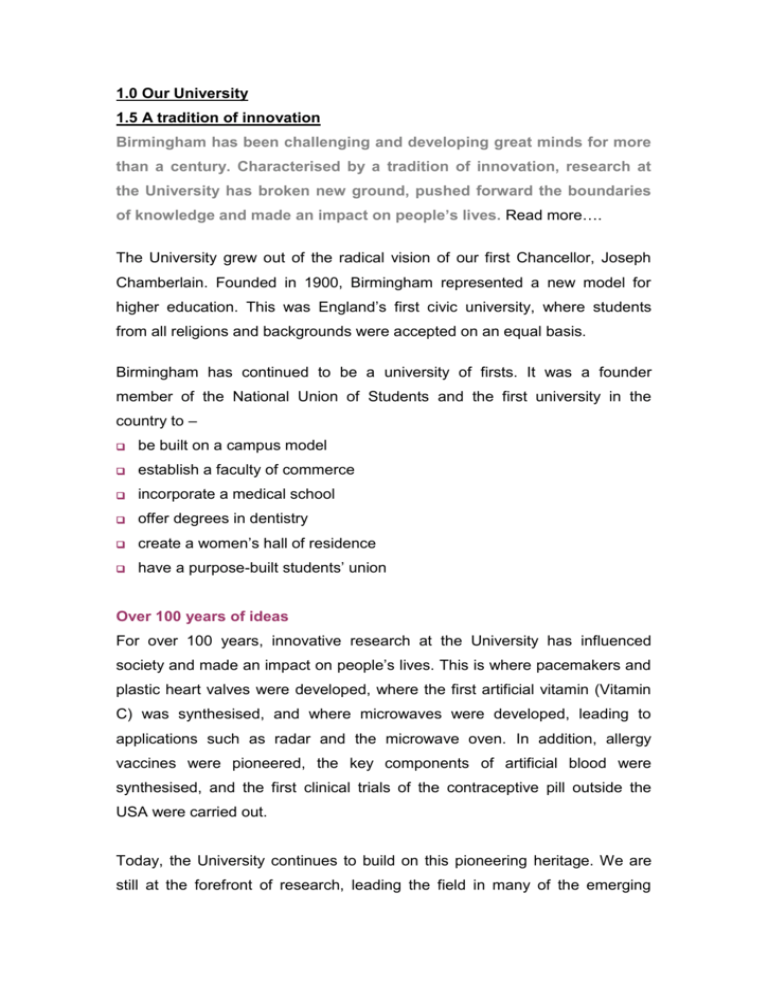
1.0 Our University 1.5 A tradition of innovation Birmingham has been challenging and developing great minds for more than a century. Characterised by a tradition of innovation, research at the University has broken new ground, pushed forward the boundaries of knowledge and made an impact on people’s lives. Read more…. The University grew out of the radical vision of our first Chancellor, Joseph Chamberlain. Founded in 1900, Birmingham represented a new model for higher education. This was England’s first civic university, where students from all religions and backgrounds were accepted on an equal basis. Birmingham has continued to be a university of firsts. It was a founder member of the National Union of Students and the first university in the country to – be built on a campus model establish a faculty of commerce incorporate a medical school offer degrees in dentistry create a women’s hall of residence have a purpose-built students’ union Over 100 years of ideas For over 100 years, innovative research at the University has influenced society and made an impact on people’s lives. This is where pacemakers and plastic heart valves were developed, where the first artificial vitamin (Vitamin C) was synthesised, and where microwaves were developed, leading to applications such as radar and the microwave oven. In addition, allergy vaccines were pioneered, the key components of artificial blood were synthesised, and the first clinical trials of the contraceptive pill outside the USA were carried out. Today, the University continues to build on this pioneering heritage. We are still at the forefront of research, leading the field in many of the emerging disciplines of the 21st century, such as nanotechnology, gene therapy, robotics and the use of virtual reality in the study of archaeology. We are continually developing new initiatives to enrich our teaching and learning. Inset box Our Nobel Prize winners From revealing the structure of DNA to developing new treatments for heart disease and cancer, the research and work of our Nobel Prize winners has made an impact worldwide. Read about them here…Link to Alumni section: Nobel Prize winners 5.6.2 Inset box Crossing boundaries The University was established to be ‘a school of universal instruction’, in the words of Joseph Chamberlain. This interdisciplinary approach remains a distinctive feature of research and learning at Birmingham today. We encourage dialogue across traditional subject boundaries and enable students to explore the links between the many different disciplines that co-exist here. This can lead to a broader understanding of a subject area, a quality appreciated by employers and in later academic life. Inset box Building great minds Our graduates embody Birmingham’s tradition of innovation and achievement, and many have risen to the top in a wide range of fields. See our Alumni section (link to alumni pages) Inset box: power statement Birmingham is a pioneering university, founded on a tradition of excellence and invention, yet with a dynamic vision of the future. Inset box Alta Innovations Ltd The University’s technology transfer company links academic research with business to generate new ideas, technologies and processes required to achieve competitive advantage. Find out more hyperlink: http://www.alta.bham.ac.uk/ 1.5.1 Our past present and future The University of Birmingham was established by Royal Charter in 1900 and was the UK’s first civic university. The first phase of building work on the campus was completed in 1909, and we celebrated our centenary in July 2009. Read more about our history… Birmingham grew out of Mason College, which can trace its roots back to the medical education seminars of Mr John Tomlinson in 1767–68. He was the first surgeon to the Birmingham Workhouse Infirmary and his 28 weekly lectures on anatomy were the first ever held outside London or south of the Scottish border. The late 19th century was a period of great regeneration for Birmingham, establishing it as a city of architectural significance. What is a civic university? A civic university is one of six regional universities established during the Victorian and Edwardian eras designed to meet the higher education needs of local people, especially in terms of business and industry. They offered a very different experience to the ancient universities of Oxford and Cambridge, both in terms of their location within large provincial towns and the socio-economic backgrounds of their students. They also operated differently; concentrating on scientific research, practical professional training, regional service and more open access to higher education for ordinary working people who were not from academic families. Some civic universities developed from colleges founded by individuals, others from colleges formed as a result of local pressures. Who are the six original civic universities? The six civic or ‘redbrick’ universities are – The University of Birmingham – 1900 The University of Liverpool – 1903 The University of Leeds – 1904 The University of Sheffield – 1905 The University of Bristol –1909 The University of Manchester – formed in 2004 with the merger of Victoria University (1880) and UMIST (1956) The term ‘red brick’ or ‘redbrick’ is a more informal term used to refer to the six civic universities. Did you know? All six of the original civic universities are members of the Russell Group Mason College Mason Science College was founded by Kidderminster-born Josiah Mason in 1875. From humble beginnings, Mason made his fortune by making key rings, pens, pen nibs and electroplating. He became one of the country’s most esteemed industrialists and philanthropists and was knighted for his generosity in establishing a great orphanage in Erdington – not bad for someone who was almost entirely self-taught. The College became Mason University College in 1898 with the Right Honourable Joseph Chamberlain MP becoming the President of its Court of Governors. Thanks to Chamberlain's tireless work, the University was granted a Royal Charter by Queen Victoria on 24 March, 1900 – and with the generous donation of land and funds, the University of Birmingham was born. Chamberlain’s vision ‘A great school of universal instruction’ Read more…. In 1900, great institutions of higher learning in the UK existed in Cambridge, Oxford, London, Durham, Manchester, Leeds, Liverpool, Edinburgh, Glasgow and Belfast. While compulsory education had been introduced in 1880 for children between the ages of 5–10 years old, the majority of the population entered work by the age of 14. Joseph Chamberlain, the great Birmingham-born politician, was well aware of these limiting factors when he proposed the establishment of the University of Birmingham, to complete his vision for the city. Chamberlain sought to provide ‘a great school of universal instruction’, so that ‘the most important work of original research should be continuously carried on under most favourable circumstances.’ It was his ambition that ‘the individual trades of the new University [would] forever associate their name and their industry with this new institution.’ Many aspects of Chamberlain’s vision continue to inspire and guide the University today, including our continuing responsibilities to our region, providing a skilled, professional workforce and groundbreaking research to inform regional industries. Built on benevolence From its beginning the University was built on the good will and benevolence of its associates. Donors included many former students of Mason College, along with industry leaders who supported Chamberlain’s vision for a University to serve the city and region. Who gave what? Read… Lord Strathcona, the Scottish born Canadian financier, railroad baron and politician – donated £50,000 Andrew Carnegie, the Scottish born American steel magnate, – donated £50,000 Sir Charles Holcroft, Black Country mine owner, – donated £100,000 Lord Calthorpe – donated the initial 25-acre plot of land from his estate and provided the University with the beautiful campus we are still proud of today <Link to alumni ‘Giving’> Then and now See how we have changed since 1900… In 1900 the University had: 678 students (189 undergraduates and 489 postgraduates) 1,297 individual undergraduate and postgraduate courses 28,000 volumes in its Library In 2010 the University has 30,415 students (18,480 undergraduates and 11,935 postgraduates) 1,128 individual programmes (478 undergraduate, 525 postgraduate and 125 continuing professional development) Over 2.5 million books and over 3 million manuscripts, including 80,000 rare and important items in our Special Collections dating back to 1471 (THIS COULD ALSO BE AN INSET BOX) Did you know? The University of Birmingham has only had six Chancellors since 1900. Find out who they are… 1. The Rt Hon Joseph Chamberlain 1900–1914 Great Birmingham politician; recognised as our founding father 2. The Rt Hon Robert Cecil, 1st Viscount Cecil of Chelwood 1918–1944 Prime Minister’s son and Nobel Peace Prize winner 3. The Rt Hon Anthony Eden, Earl of Avon 1945–1973 Conservative politician, foreign secretary and British Prime Minister 4. Sir Peter Scott 1973–1983 Son of Scott of the Antarctic; a renowned ornithologist, conservationist and painter 5. Sir Alex Jarratt 1983–2002 British businessman and senior civil servant 6. Sir Dominic Cadbury 2002–present British businessman and member of the Cadbury chocolate dynasty INSET BOX Joseph Chamberlain was the first commoner (without title or rank) in 240 years to hold the post of Chancellor of a British university, and the first not to have been a member of the Established Church. Historical trivia Find out more historical facts about the University of Birmingham… PERHAPS WE COULD DO THIS AS A TIMELINE 1847: Dr Langston Parker is the first person to use ether as an anaesthetic 1880: The Lapworth Museum of Geology opens; it is now one of the oldest specialist geological museums in the UK and has been formally designated as being ‘of outstanding National and International Importance’ 1891: John Henry Poynting, Professor of Physics, calculates the weight of the Earth 1900: The University of Birmingham receives its Royal Charter 1900: Florence Price becomes the first woman to matriculate and take a medical (MBChB) degree 1902: Sir William Ashley founds the Faculty of Commerce; the first of its kind in Britain 1905: Edward Elgar becomes the Peyton Professor of Music; he is succeeded in 1908 by his friend, Granville Bantock, who became instrumental in founding the City of Birmingham Orchestra 1908: The Birmingham Law School is established 1909: The Aston Webb Building is officially opened by King Edward V11 1909: The 325 foot clock tower named ‘Old Joe’ in honour of our founder, was completed; it can still be seen for miles around 1914–1918: The University’s Great Hall was used as the First Southern General Hospital with 520 beds 1922: Francis William Aston receives Nobel Prize in Chemistry for inventing the Mass Spectrometer 1932: The opening of the Guild of Students Building 1937: Sir Norman Haworth receives the Nobel Prize in Chemistry for his work on carbohydrates and Vitamin C 1937: Lord Robert Cecil is awarded the Noble Peace Prize for his work with the League of Nations 1937: The University acquires the 18th Century bronze equestrian statue of King George 1 1939: The magnificent Barber Institute of Fine Arts, designed by Robert Atkinson, was opened; it remains one of the finest Art Deco buildings in the country 1939–1945: The University Great Hall is used as a gymnasium 1940: The cavity magnetron (microwave technology and radar) was developed in the Physics Department by John Randall, Harry Boot and Jim Sayers 1944: John Macdonald Nicholson donates Winterbourne House and gardens to the University 1945: The Barber concert hall opens to the public for the first time 1946: Sir Peter Scott founds the Severn Wildfowl Trust (later to become the Wildfowl and Wetlands Trust) in 1946; he is knighted in 1973, the same year he becomes Chancellor of the University of Birmingham 1946: Birmingham offers the first ever sports-based degree 1947: The School of Education is established; it is now one of the largest schools of education in the UK 1949: Birmingham-born Dame Hilda Rose becomes the first female professor of the University Medical School 1951: The Shakespeare Institute is established in Stratford-upon-Avon 1956: The first MSc programme in Geotechnical Engineering began; it was entitled ‘Foundation Engineering’ and continues to run to this day: in the same year, the MSc programme in Physics and Technology of Nuclear Reactors also began 1958: Birmingham offers its first programmes in Biochemical Engineering 1960: Sir Peter Medawar is awarded the Nobel Prize (jointly) in Physiology or Medicine for his pioneering work in transplant surgery 1960: After groundbreaking research at Birmingham, the first heart pacemaker is fitted by surgeons at the Queen Elizabeth Hospital 1962: Professor Maurice Wilkins was awarded the Nobel Prize (jointly) in Physiology or Medicine for his contribution to the discovery of DNA. 1968: Professor Charlotte Anderson demonstrates the role of gluten in celiac disease, leading to the introduction of gluten-free diets 1972: The University begins work on the Raymond Priestly Centre, for outdoor pursuits and field studies, on Coniston Water in the Lake District 1973: The University railway station was opened: Birmingham is one of very few universities to have their own railway station 1973: Alta Biosciences was founded; today it is recognised as a leading manufacturing laboratory 1980: Post-punk band Joy Division performed their final gig at the University; they later reformed as New Oder 1982: Sir John Vane is awarded the Nobel Prize (jointly) for Medicine for his work with aspirin and related painkillers 1982: The Birmingham ElectroAcoustic Sound theatre (BEAST) is founded by Professor Jonty Harrison 1982: The Ironbridge Institute offers postgraduate courses in Industrial Archaeology and later (1987) in Heritage Management 1985: The Astrophysics and Space Research Group develop and manufacture the X-ray telescope used on board the space shuttle Challenger 1990: The University offers Britain’s first ever course in Playwriting 1995: Former student, Lisa Clayton, is the first British woman to sail singlehanded and non-stop around the world in her thirty-eight foot yacht Spirit of Birmingham 1997: Birmingham becomes a member of Universitas 21: in 2002, Birmingham is home to the new, centralised U21 Secretariat 1998: The University becomes one of the first universities in Europe to be awarded the prestigious Jean Monnet Centre of Excellence title; this was reaffirmed in 2006 2000: Birmingham celebrates its centenary and prominent modern artist Eduardo Paolozzi donates his sculpture Faraday as a gift 2001: Sir Paul Nurse is awarded the Nobel Prize (jointly) for Physiology or Medicine for his work on cell cycle regulation 2002: Birmingham students are the first top get handheld learning organisers 2002: Birmingham researchers develop new urine test to help fight against the rise in TB 2002: Birmingham’s oldest student, 71 year old Sheila Hopkinson, is awarded her doctorate after nine years part-time study 2003: Birmingham is one of only four leading UK universities to join forces with a major communications corporation to launch a U21 Global Online MBA 2003: Birmingham is awarded Fair Trade status 2004: The University works with Birmingham children’s Hospital to pioneer the diagnosis and treatment of children’s brain tumours 2005: Birmingham is designated as a ‘centre of science expertise’ 2006: Researchers at the Medical School develop the worlds first over the counter home fertility test for men. 2007: Professor Peter Bullock is awarded the Nobel Prize (collectively) for his work on treating soil as a sustainable resource 2007: The Department of Theology and Religion hosts an international conference on the Dead Sea Scrolls 2008: The Research Assessment Exercise reveals that 89.9% of Birmingham’s research activity has international impact 2008: Birmingham unveils the only gas fuelling station in England and five hydrogen powered cars, making it the only UK university to run a fleet of vehicles powered in this way 2008: Birmingham opens its first overseas office in New Delhi 2008: Birmingham reorganises into five Colleges 2009: Professor David Eastwood becomes Vice-Chancellor 2009: Birmingham becomes the first link in a unique chain of Cancer Research UK centres 2009: University of Birmingham Sport staff member Norman Beech, and his son James, become the first British father and son team to row across the Atlantic 2009: The University launched its Circles of Influence campaign to raise £60-million for projects that include research into brain injury, cancer, healthy ageing and practical clean energy, as well as a new concert hall, a targeted scholarship programme, and a centre for heritage and cultural learning 2010: Scientists discover that a gene called DAF-16 is involved in determining the rate of ageing and average life span in laboratory worms; with implications that it may open up new avenues for altering ageing in humans 2010: Researchers create ‘healthy’ chiocolate 2010: The University of Birmingham and the city are honoured for promoting international collaboration 2010: Work begins on the new 450-seat concert hall, which will complete the red brick semi-circle of buildings that have been at the heart of the University since 1909 Jean Monnet Jean Monnet (1888–1979) was a French civil servant who became an expert on international collaboration and served as a consultant at the Paris Peace Conference in 1918. He was nominated deputy to the secretary-general of the League of Nations. At the outbreak of the Second World War he moved to Washington where he chaired a committee promoting Anglo–French economic collaboration. He later became president of the Action committee for the United States of Europe. Vice Chancellors of the University of Birmingham Find out who has been Vice-Chancellor of this prestigious university since 1900. Charles Gabriel Beale (1843–1912) Birmingham’s first Vice-Chancellor from 1900 until 1912 A politician and ornithologist, he was also Lord Mayor of Birmingham between 1897 and 1899 and again in 1905. Sir Gilbert Barling (1855–1940) Vice-Chancellor from 1913 until 1933 An eminent physician, he was instrumental in the development of what is today known as Cancer Research UK. Sir Charles Grant Robertson (1869–1948) Vice-Chancellor from 1919 until 1938 A British academic historian, he had once been a tutor to the Prince of Wales, later to become King Edward VIII, who abdicated the throne in 1936. Professor Humphrey Francis Humphreys (1885–1977) A professor of dental surgery, he was Vice-Chancellor from 1952 until 1953 Raymond Priestly (1886–1974) Vice-Chancellor from 1938 until 1953 Sir Robert Aitkin (1901–1997) Vice-Chancellor from 1953 until 1968 New Zealand born, he was one of the most influential figures in medicine in post-war Britain. Under his leadership, the University doubled its annual intake of students. Professor Michael Sterling (1946–present) Vice-Chancellor from 2001 until 2009 Professor David Eastwood (1959–present) Vice-Chancellor since 2009 < LINK TO PROFILE OF CURRENT V-C > <INSET BOX> Did you know? British Prime Minister Stanley Baldwin (in office 1935–1937) was sent to Mason Science College by his father. Baldwin was eventually succeeded as Prime Minister by Neville Chamberlain, another pupil of Mason Science College, and the son of Joseph Chamberlain, our first chancellor! 1.5.2 Innovation today Innovation today The University of Birmingham has always had a central role in the life of the West Midlands region, having been founded with the purpose of training the city’s – and the world’s – future business leaders. We continue to be at the forefront of technological innovation today, with our wealth of global expertise and excellence in teaching, and remain the university of choice for many students. With a diverse range of subjects researched and taught across the whole spectrum of the arts, humanities, social sciences, engineering, and the life and physical sciences, the University of Birmingham is the leading university in the West Midlands and we strive to maintain our position as one of the best, broadly-based institutions in the UK. We have always sought to educate our students in ways that will best equip them for the world of work. As a result, our graduates have always been much in demand by employers, who recognise the quality of a degree from the University of Birmingham. In addition, we have been particularly successful in attracting external funding, having been awarded more than £70 million in the past five years for new buildings, state-of-the-art equipment, and in establishing this University as the UK leader in the delivery of web-based teaching. Thus, we are combining the traditions of our first century with the vision required to take us forward into our second. Entrepreneurship and Innovation Entrepreneurship and Innovation at the University of Birmingham, part of the Careers and Employability Centre aspires to encourage and promote enterprise, innovation and entrepreneurship amongst students, staff and alumni. It offers a range of programmes and services from giving support for business start-ups to competitions, for example: (Link following to text below) SPEED WM programme Talent Pool programme B-SEEN programme Plan B competition Enterprise Skills Series Postgraduate Enterprise Summer School 1:1 business readiness coaching Online learning Personal Skills Award SPEED WM programme – providing students with the opportunity to turn a business idea into reality by developing business skills, availability to funding and incubation facilities in a supportive environment Find out more hyperlink: currently at: http://www.as.bham.ac.uk/ei/programmes/speedwm.shtml Talent Pool programme – a unique programme for postgraduate students providing customised training and access to practical, ‘real-life’ opportunities to develop the next generation of academics, business consultants and entrepreneurs Find out more hyperlink: currently at: http://www.as.bham.ac.uk/ei/programmes/talentpool.shtml B-SEEN programme – the Skills for Enterprise and Employability Network will provide business start-up support to recent graduates across the city of Birmingham: together with Birmingham City and Aston universities, we will be providing incubation facilities and training to 90 graduates Find out more hyperlink: currently at: http://www.as.bham.ac.uk/ei/programmes/b_seen.shtmlBirmingham Plan B competition – a University-wide competition to uncover the best talent, the best ideas and the new generation of entrepreneurs: ideas should address one of the University's key research themes of saving lives, influencing society and creating sustainability Find out more hyperlink: currently at: http://www.as.bham.ac.uk/ei/planb/index.shtml Enterprise Skills Series – providing help with starting a business, going freelance, running a charity, society or social enterprise, and enterprise skills to boost your employability Find out more hyperlink: currently at: http://www.as.bham.ac.uk/ei/programmes/ess.shtml Postgraduate Enterprise Summer School – a great opportunity for postgraduate research students to learn about Enterprise and Entrepreneurship: topics covered include innovation, marketing, business planning, financing, commercialisation and presentation skills Find out more hyperlink: currently at: http://www.as.bham.ac.uk/ei/programmes/pess.shtml 1:1 business readiness coaching – providing guidance and support for those with a business idea: these one-to-one meetings can be just the right thing to get you started Find out more hyperlink: currently at: http://www.as.bham.ac.uk/ei/programmes/121surgeries.shtml Online learning – EI WebCT self-enrol courses can help if you want to know more about entrepreneurship or business start-up: videos, course notes and self-analysis tools can help you discover whether you or your idea are ready for success Find out more hyperlink: currently at: http://www.as.bham.ac.uk/ei/programmes/webct.shtml Personal Skills Award – providing students with the opportunity to earn points towards the award through enterprising activities and contributing to two Enterprise modules Find out more hyperlink: currently at: http://www.as.bham.ac.uk/ei/programmes/psa.shtml Innovation and enterprise at the University Graduate School Birmingham entrepreneurs can be found running every kind of enterprise and in many sectors. A number of students from the University have gone on to become successful entrepreneurs. Read about past and present successes here: (current hyperlink: http://www.as.bham.ac.uk/ei/success) Research involves innovation All academic research aims to add something new to existing knowledge or ways of doing things. Therefore all researchers must be innovative as this is one criterion by which they are judged. Innovation Innovation generates new value that may create wealth or enrich the culture of our society. Being aware of the innovations you are responsible for is important. This may generate personal wealth or ensure that the innovation is used in the way intended. Enterprise Enterprise is having the confidence and courage to take charge and make something happen. It can be complementary to innovation and may be what is needed to ensure that an innovation really has the impact that it has the potential to. Inset box (design as a formula) I + E = NB The combination of Innovation and Enterprise equals New Business For further information: Telephone: 0121 414 8775 Email: eic@contacts.bham.ac.uk www.eic.bham.ac.uk Inset box Innovation & Technology Observatory Regions that are able to fully exploit their capacity for innovation enjoy rapid economic growth and high living standards. Through our partnership with the HEROBC (higher education reach out to business and the community) initiative, we’ve supported the creation of an Innovation and Technology Observatory. The Observatory is a key regional resource, analysing innovation in different industrial sectors across the region, examining technology trends and the take-up of new technologies. These results enable a regional innovation strategy to be implemented. Find out more hyperlink: currently at: http://www.industry.bham.ac.uk/services/innovation.shtml Current research triumphs 1.5.3 We are changing the world… we are Birmingham We are changing the world… we are Birmingham Research at Birmingham combines creative thinking with practical application. Our partnerships with industry, government and the public sector ensure that our research contributes to developments on a regional, national and international level. Read more… The following examples demonstrate the impact of our research on the city and society generally: Adult Social Care in Need of a Radical Overhaul Medical research to improve quality of life for diabetes patients Cancer Research UK Launch National Children's Cancer Trials Team in Birmingham Birmingham Archaeology uncovers the largest hoard of Anglo Saxon Gold ever found Scientists Celebrate First Physics Results from the Large Hadron Collider (Link to the text below) Adult Social Care in Need of a Radical Overhaul In February 2010, researchers from the University called for a radical overhaul of the adult social care system in the UK. The Case for Social Care Reform – the Wider Economic and Social Benefits, which was produced by the University of Birmingham’s Health Services Management Centre, concludes that without a radical rethink of current priorities the real cost of providing social care will double in the next twenty years. An improved social care system could generate significant savings by reducing the number of hospital admissions and the pressure on emergency hospital beds. The report also argues that helping social care users into paid employment could reduce social security spending whilst also providing a significant boost to the economy. Find out more hyperlink currently at: http://www.newscentre.bham.ac.uk/press/2010/02/Social_Care_Reform_8_2_ 10.shtml Medical research to improve quality of life for diabetes patients University of Birmingham scientists are carrying out pioneering research that aims to improve care for diabetes patients in south Birmingham where more than 14% of all deaths are related to the condition. Consultants are working with people diagnosed with Type 2 diabetes to evaluate education and support packages and discover better ways of reaching the community’s diverse social and ethnic groups. The study will measure the benefits for those taking part, determine why others are not taking up the care on offer and identify how barriers can be overcome to improve patients’ quality of life. (Find out more hyperlink currently at: http://www.newscentre.bham.ac.uk/press/2010/02/Diabetes_research.shtml Cancer Research UK Launch National Children's Cancer Trials Team in Birmingham Birmingham will be at the forefront of developments in childhood cancer research thanks to the launch of a new centre which will co-ordinate groundbreaking clinical trials across the UK. The Cancer Research UK Children’s Clinical Trials Team at the University of Birmingham will play a major role in the development of new treatments for childhood cancers. Clinical trials are essential to develop new treatments for cancer by testing the latest drugs and discovering the best ways to use both new and existing treatments. Currently around 60 per cent of children with cancer are on a trial in the UK and this high level of participation in clinical research has had a major impact on the development of successful treatment strategies used today. A combination of research and clinical trials has made a huge difference in the number of children surviving cancer. Today, three quarters of children are successfully treated, compared with just a quarter in the 1960s. Find out more hyperlink currently at: http://www.newscentre.bham.ac.uk/press/2010/04/Cancer_Trials_Press_Rele ase_15_4_2010.shtml Birmingham Archaeology uncovers the largest hoard of Anglo Saxon Gold ever found Thursday 24 September 2009 marked an unprecedented announcement of the largest ever discovery of Anglo Saxon Gold, investigated by Birmingham Archaeology, part of Institute of Archaeology and Antiquity in the University's College of Arts and Law. The hoard was discovered by Terry Herbert, who was detecting on private farmland with the written consent of the landowner. Following the initial find, Staffordshire County Council invited Alex Jones, Director of Birmingham Archaeology and colleagues to excavate the site. What emerged will surely redefine the dark ages. A hoard comprising in excess of 1,500 individual items, consisting mostly of gold, many decorated with precious stones. The find is set to alter our perceptions of Anglo Saxon England. It is the equivalent of discovering a new Book of Kells or the Lindisfarne Gospels. Find out more hyperlink currently at: http://www.newscentre.bham.ac.uk/press/2009/09/Anglo_Saxon_Press_Rele ase_28_09_09.shtml Scientists Celebrate First Physics Results from the Large Hadron Collider Birmingham physicists played a key role in producing the first results from CERN’s Large Hadron Collider (LHC), a 27km underground tunnel near Geneva, where scientists are colliding together particles to discover what happened a millionth of a second after the Big Bang. These results have come out of the ALICE collaboration’s detector which will study the physics from ultra-high energy proton-proton and lead-lead interactions. Protons were collided at the LHC for the first time at relatively low energies. Physicists from the University of Birmingham played a key role in analysing these collisions and producing the first results from the atom-smasher near Geneva. ‘I’m immensely proud of the team who have worked so hard’, said Dr David Evans, head of the University of Birmingham’s ALICE group at the School of Physics and Astronomy. ‘They have been working around the clock at CERN in order to get these results out so quickly.’ The Birmingham group have also designed and built the vital ALICE trigger electronics which instruct the detector to record data after a collision, making decisions in less than a tenth of a millionth of a second. Find out more hyperlink currently at: http://www.newscentre.bham.ac.uk/press/2009/12/01Dec09LHCfirstcollisions. shtml 1.5.4 Birmingham heroes NB: I have rewritten the introduction to avoid the repetition of the words ‘research’ and ‘world’, which were in the original intro. CW Birmingham heroes Research at Birmingham has had a global impact for over 100 years. From world-class cancer studies to the development of a new generation of fuels, our academic expertise continues to address today’s key national and international challenges. Quote style statement We undertake the kind of groundbreaking research that creates solutions to existing and future problems; that ultimately has an impact on real life issues – on you. Bulleted list linking to text below Research areas Our heroes: the people behind the research Invest with us – be a ‘hero’ (Links to text below) Research areas Our research areas are extensive and diverse; embarked upon by recognised world-leading experts in their field. There are four major areas in which we play a lead role: social affairs; education; the urban environment, and global security. 1. Social affairs – our research in this field is varied and far reaching, spanning topics from the reform of the health and social care systems through to the increased need for socially responsible business, in the light of the recent banking crisis. 2. Education – our pioneering research and evaluation of education is used to inform policy-makers, assist practitioners and enhance opportunities for all learners: it covers a broad spectrum of topics from special needs education (SEN), international education, the history of education and practical teacher training. 3. The urban environment – developing social, economic, psychological, environmental and infrastructural resilience is critical for the long-term survival of the human race, and Birmingham’s new research initiative will have far-reaching influences on understanding and enhancing resilience. 4. Global security – our outstanding research covers a huge range of topics from the challenges of state-building in Africa to the politics of post-Soviet Russia: we are also involved in major projects to assess the impact of new security technologies on our personal rights. Quote style impact statement We ask questions. We create impact. We use our research expertise to solve tomorrow’s problems today. Our heroes: the people behind the research University of Birmingham research is carried out in key specialist areas by experts who, by definition, are highly qualified, skilled and outstanding leaders in their fields. You can find out more about their individual research interests below. (Links needed for all) NB: I suggest we do these (areas and names) in alphabetical order to avoid any suggestions of a hierarchy of research/researcher importance. We link to people’s profiles as on our current site. Ageing Professor Glyn Humphreys Professor Janet Lord Professor Chris Miall Dr Anna Phillips Cancer Professor Jon Frampton Dr Pam Kearns Professor Paul Moss Dr Daniel Palmer Professor Lawrence Young Creating a fairer society Professor Jon Glasby Professor Karen Rowlingson Professor Isabelle Szmigin Education Professor James Arthur Professor Stephen Gorard Professor Ann Lewis Fuels Dr Waldemar Bujalski Professor Martin Freer Professor Lynne Macaskie Dr Bruno Pollet Dr Joe Wood Global security Professor Paul Jackson Professor Tom Sorell Health service Professor Jon Glasby Professor Richard Lilford Other medical research Professor David Adams Professor Laura Piddock Professor Paul Stewart Shaping communities Dr Jenny Phillimore Dr Basia Spalek Urban resilience Professor Jon Coaffee Professor Kalanithy Vairavamoorthy Invest with us – be a ‘hero’ We continually accomplish exciting breakthroughs and invest in the future in areas such as energy, engineering, heritage, materials, medicine, and social policy – then we make them available to the people who will benefit most. That could be you. As a world-leading research University we offer a wide range of services to help you invest with us, including: Access to licensing and intellectual property Access to our graduates and postgraduates Consultancy Contract research Funded support Spin-out companies We conduct cutting-edge research in sectors such as: cancer research and clinical trials; hydrogen energy; nanotechnology, and other equally important areas of study. Our research influences public and government policy, and our clients include some of the leading global players, such as: Can we have bullets in three columns of five? AirBus Defra Joseph Rowntree Astra Zeneca Epson Alston Ford Kodak BP GKN Nestle British Gas GlaxoSmithKline Pfizer Foundation Rolls Royce To find out more about how you can work with our experts and be part of our future success, visit www.industry.bham.ac.uk. CAN WE KEEP THE ROLLING HEROES STATEMENTS AND STATIC STRAPLINE? Tara: over to you on this. WE ARE 1. Developing robots to retrain the ageing brain 2. Harnessing viruses in the fight against cancer 3. Investigating the realities of health, wealth and happiness 4. Shaping the cities of the future 5. Showing that society is evolving not breaking 6. We are making sure there is life after oil Birmingham Heroes: Solving tomorrow’s problems today CAN WE DO SOMETHING WITH THIS: MORE PROMOTIONAL THAN ANYTHING? Right-hand tabs of screen Birmingham Heroes are everywhere! Use one of posters for picture Not only can you see our Heroes on the University website and in our publications, but you can find them on posters and billboards throughout the city, on Virgin trains and even on the London Underground! Send us your feedback on our Heroes campaign – or tell us when and where you spot one of our campaign posters – by emailing: alumnicommunications@contacts.bham.ac.uk Watch and listen to our Heroes on You Tube >> Keep existing media (You Tube video) content 1.5.5 The next five years The next five years As a research-intensive university, we are committed to carrying out research that is world leading in terms of its originality and distinctiveness, significance and rigour. Read more… Research will build upon our international connections; will set international agendas rather than follow them; and capitalise and expand upon our existing distinctive multi- and inter-disciplinary research strengths to address key national and global challenges. Our Colleges will promote research of originality and impact We will identify novel partnerships with national and international commercial and charitable bodies to ensure a diversity of income sources to compensate for the reduction in public funding, and to enable us to continue to grow our community of scholars. We will attract the best research students, both nationally and internationally, and provide a supportive and dynamic intellectual community to attract and develop high quality research faculty. We will undertake significant enrichment work, reaching out to attract world leading researchers from any discipline, with innovations that will add a global dimension to our innovative thinking. We will measure our success in this goal by reference to our market share of competitively awarded research grant income; and by the rate of growth of citations of our academic faculty. Link to Strategic Framework document We could also make links to our Historic Timeline Inset statement In an environment where knowledge innovation is prioritized by governments, hard-won intellectual capital and intellectual property must be properly transformed into benefits for the University, the community in which it operates and the wider economy, policy and society. Inset statement Engagement with business and government partners will open new avenues for innovative research and provide opportunities to translate blue sky research born of our culture of innovation and enquiry into practical solutions in industry, cultural projects and healthcare. Inset box More than a century of groundbreaking research Our partnerships with industry, government and the public sector ensure that our research contributes to developments on a regional, national and global level. 1891 John Henry Poynting, Professor of Physics at the University, calculates the weight of the Earth 1940 University of Birmingham scientists invent a device to produce microwaves, which lead to the development of radar and the microwave oven 2001 Researchers at the University develop the first male home fertility test 2004 Birmingham develop micro engines that carry 300 times more energy than batteries, but are a fraction of the size 2008 A zero-emission, environmentally friendly car powered by hydrogen, the world’s first hydrogen-hybrid canal barge and a £2 million house with utilities powered by hydrogen are examples of our work in developing a viable alternative to fossil fuels 2009 The University’s prominence in energy research is recognised through its co-hosting of the national Energy Technologies Institute 2009 Birmingham researchers are using a genetically modified version of the common cold virus to kill cancer cells 2009 Birmingham named as Cancer Research UK's first national Cancer Centre, leading the battle against this life-threatening condition 1.5.6 Did you know? Did you know? Out of over 8,000 universities in the world, we are ranked in the top 100 in both the academic ranking of world universities and the Times Higher Education world university rankings (Link out to ‘League tables’ information) 4,000 international students from 150 different countries, make Birmingham one of the largest international student communities in the UK (Link out to ‘International’ section) The University owns more than 2.5 million books including its Special Collection of over 80,000 pre-1850 books and 3 million manuscripts dating from 1471 (Link out to ‘Facilities and Special Collections’) The University still employs a glass blower to make specific items for precise experiments (Link out to ‘Research’ and ‘Colleges’ information) A nest box has been placed at the top of the clock tower where a pair of peregrine falcons nest every year (Link out to ‘Beautiful campus’) From the inspirational to the bizarre, you can find 100 fascinating facts about us by downloading our publication ‘Fact.’ from here (Provide link to PDF) Show picture of it, too (maybe an open spread rather than the front cover). NB: CAN WE SUPPLY ADOBE READER DOWNLOAD? Note This was going to be an online version of the University’s publication ‘Fact.’, which contains a selection of images and information about Birmingham – from our motto to the kinds of groundbreaking research we undertake. I have had a PDF created of the publication. I may strip the text out of the PDF at a later date, so we can use the material across the University in other ways. In the meantime, I have chosen a few facts, showing the breadth of information the publication contains, with a link to the downloading of it. CW

